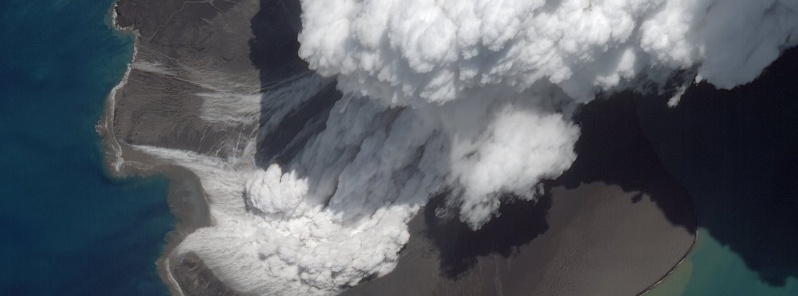New cracks discovered at Anak Krakatau raise new landslide and tsunami fears, Indonesia

While volcanic activity continues at Indonesian Anak Krakatau, authorities said they've discovered new cracks running through the remaining island. The discovery raises fears that another potentially large-scale landslide and tsunami could be produced.
According to Dr. Dwikorita Karnawati, head of the Indonesian Meteorology, Climatology and Geophysics Agency (BMKG), two cracks appeared after the volcano's height dropped from 338 m (1 108 feet) to 110 m (360 feet) following its eruptions at the end of December 2018.
"From the latest we have seen from the air, the mountain is sloping and smoke is rising from beneath the sea water. And on the body of the mountain, we can see from the surface, there are cracks that continue to emit smoke," she said. "The cracks are certainly deep", unlike normal gaps, she added, as reported by the Straits Times.
"What we are worried about is that if there is another eruption, the cracks might connect and weaken the slope, causing part of the mountain to collapse again," Dwikorita said.
"Of course the hope is that it will not be like what happened on December 22, but we ask the public to be vigilant when they are in the 500 m (1 600 feet) zone around the coast."
The part of the volcano that could collapse currently has a volume of about 60 million m3 – smaller than the 90 million m3 of slope that slid into the Sunda Strait on December 22, displacing massive amounts of water that sent waves up to 5 m (16 feet) high crashing into densely populated areas on Sumatra and Java islands.
Nevertheless, this is quite sufficient for another very dangerous tsunami. Plus, the island is still growing.
Another stunning @planetlabs SkySat image of #AnakKrakatau on Jan 4. Phreatomagmatic activity is filling in the bay above the vent. Copyright 2019 Planet Labs Inc and h/t @rsimmon. @Sutopo_PN @vulkanologi_mbg pic.twitter.com/4XtGQf0RzZ
— Simon Carn (@simoncarn) January 5, 2019
According to Volcanic Ash Advisory issued by the Darwin VAAC at 10:24 UTC on January 5, 2019, regular volcanic ash emissions to 10 km (33 000 feet) are moving ESE. Discrete eruptions to 13.7 m (45 000 feet) moving WSW are occurring every 3 to 6 hours and dissipating quickly.
"This behavior has persisted for over 48 hours," the center said.
The highest volcanic-plume I've ever seen above #Krakatau with a super nice sunset to go with it. Several lightning bolts were observed inside the plume after sunset. Wondering how high it is, any guess? #anakkrakatau #volcano @id_magma @Sutopo_PN pic.twitter.com/6rsriskgwL
— Øystein Lund Andersen (@OysteinLAnderse) January 4, 2019
Timelapse of a Surtseyan eruption, accompanied by a large base surge at #AnakKrakatau yesterday 4th January. Filmed from Java, 48km from the #volcano. @id_magma @Sutopo_PN pic.twitter.com/wbat6Xm7o6
— Øystein Lund Andersen (@OysteinLAnderse) January 5, 2019
The volcanic plume and cloud persists above #krakatau volcano. as of this morning – 5th January. Intermittent activity at #AnakKrakatau seem to keep it alive. pic.twitter.com/BRSgrMjJtL
— Øystein Lund Andersen (@OysteinLAnderse) January 5, 2019
Timelapse Video showing cloud growth above #AnakKrakatau as the volcano continous to erupt and produce a lot of steam – 5th January. pic.twitter.com/8ljpAPtWU3
— Øystein Lund Andersen (@OysteinLAnderse) January 5, 2019
Shipping vessel sailing South trough the Sunda Strait – passing in front of the dark eruption plume of #Krakatau volcano, this morning – 5th January. #Shipping #Indonesia #AnakKrakatau @Dianaship pic.twitter.com/fUpMEKhyLj
— Øystein Lund Andersen (@OysteinLAnderse) January 5, 2019
Alert Level for Anak Krakatau remains at 3 of 4.
Residents and tourists are not allowed to approach within 5 km (3.1 miles) of the crater.
Featured image credit: Planet Labs

Commenting rules and guidelines
We value the thoughts and opinions of our readers and welcome healthy discussions on our website. In order to maintain a respectful and positive community, we ask that all commenters follow these rules.